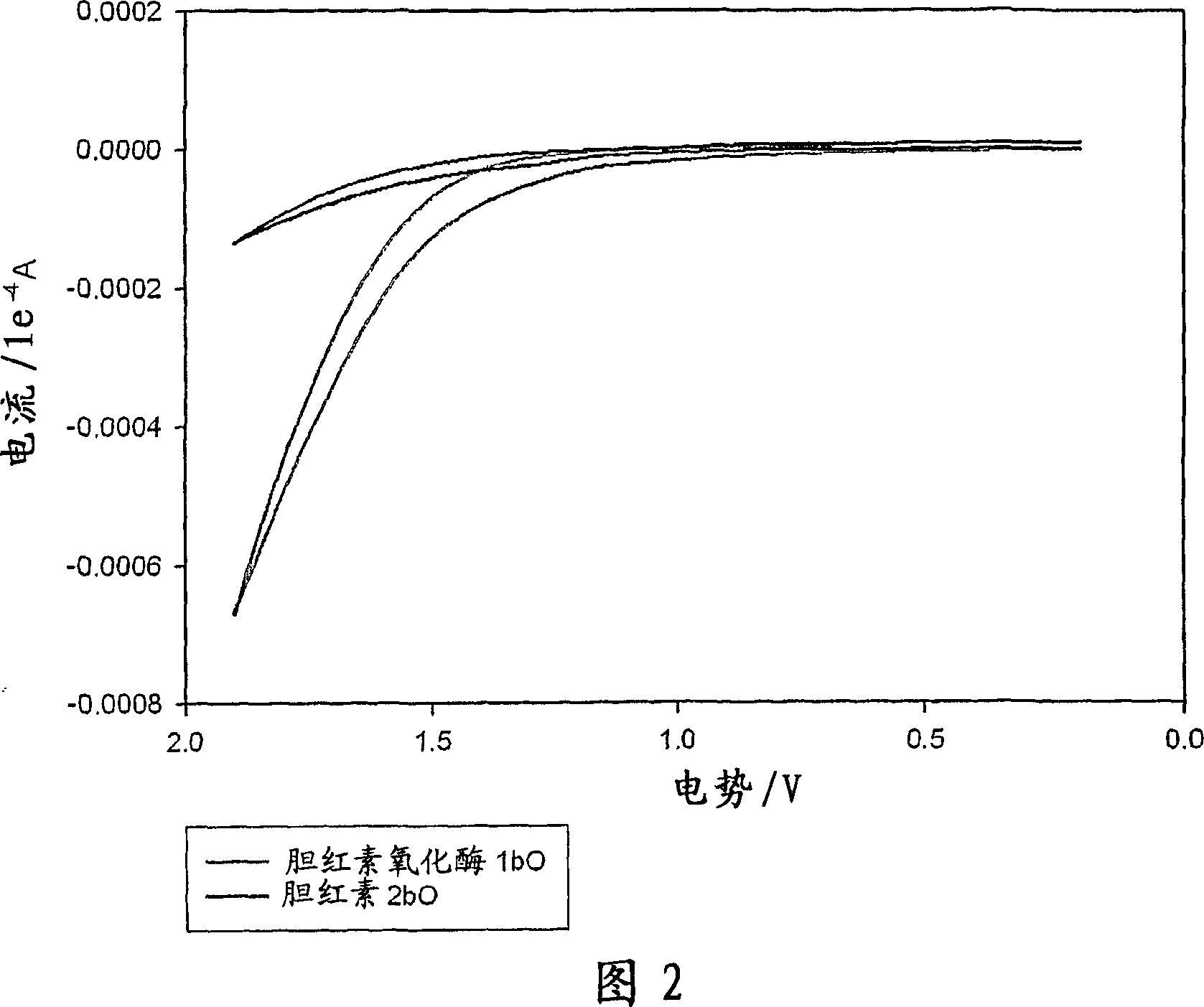Immobilized enzymes in biocathodes
A biocathode and enzyme immobilization technology, which can be used in the determination/inspection of microorganisms, biochemical equipment and methods, biochemical fuel cells, etc., and can solve the problems of toxic osmium complexes, etc.
- Summary
- Abstract
- Description
- Claims
- Application Information
AI Technical Summary
Problems solved by technology
Method used
Image
Examples
Embodiment 1
[0198] Preparation of Enzyme-immobilized Salt Extraction Membrane
[0199] Ru(bpy) 3 +2 / Preparation of Nafion I
[0200] By adding Ru(bpy) directly to the Nafion suspension 3 +2 Preparation of Ru(bpy) 3 +2 / Nafion I (mixture casting).
[0201] To prepare Ru(bpy) 3 +2 / Nafion I salt-extracted membrane (“Nafion I”), 0.15 mmol Ru(bpy) 3 +2 Add 4ml of Nafion(R), mix well by vortexing and using a sonicator in a thermostatic water bath for ~3-4 hours. The mixture was then poured into weighing boats to dry overnight. Once dry, pass the Ru(bpy) 3 +2 The Nafion(R) mixture was immersed in deionized water, salt extracted using a vortex, and centrifuged. When all the salts have been extracted, the extracted solution turns from orange to clear. Salt-extracted membranes were rinsed and dried before redissolving in 4 ml of 80% ethanol (can be redissolved in mixtures of lower aliphatic alcohols containing up to 30% water).
[0202] Cathodic enzymes were immobilized on Ru(bp...
Embodiment 2
[0212] Electrode preparation
[0213] Ru(bpy) on glass carbon electrode 3 +2 / Preparation of Nafion III
[0214] To prepare cathodic enzyme / membrane casting solution, add ~1mg bilirubin and ~0.5-1mg bilirubin oxidase to 100ml Ru(bpy) 3 +2 / Nafion III salt extracted membrane (above) and mix well (in this case, vortex for 20 minutes). 2ml of cathodic enzyme / membrane casting solution was applied to a polished glass carbon electrode (3mm diameter) and allowed to dry. Once dry, place the cathode enzyme / membrane / carbon electrode in N 2 - Degassed Ru(bpy) 3 +2 Soak in the solution for 3 hours. TBAB and Ru(bpy) 3 +2 After the exchange, lead the carbon electrode into the N 2 - Degassed pH 7.4 phosphate buffer and allowed to soak for 1 hour. After equilibration, the cathode was tested by cyclic voltammetry at scan rates of 0.05 and 0.1 V / s. Then, the buffer was saturated with oxygen for 10 minutes and the cathode was tested as above.
[0215] 1cm 2 Ru(bpy) on carbon felt...
Embodiment 3
[0221] biofuel cell
[0222] A prototype biofuel cell was fabricated (FIG. 11) comprising a bioanode comprising alcohol dehydrogenase immobilized in TBAB-modified Nafion(R) (as described in patent applications 60 / 429,829, 60 / 486,076, and 10 / 617,452) , and the Nafion III membrane contains bilirubin oxidase, bilirubin and Ru(bpy) 3 +2 (See Figure 1 for a description of the bifunctional biocathode membrane). This non-optimal biofuel cell has a PEM (Nafion(R) 117) membrane separating the anode and cathode solutions and where the catalyst loading is only ~28% of that of the membrane described in the voltammogram experiments (above), the biofuel cell Preliminary tests of the test show that the open circuit voltage is 0.4179-0.819 volts, and the maximum ionization density is 0.224mA / cm 2 to 2.23mAmps / cm 2 And the maximum power is 0.951mW / cm 2 (See Figure 12, which depicts the power curve for this prototype).
PUM
| Property | Measurement | Unit |
|---|---|---|
| diameter | aaaaa | aaaaa |
Abstract
Description
Claims
Application Information
 Login to View More
Login to View More - R&D
- Intellectual Property
- Life Sciences
- Materials
- Tech Scout
- Unparalleled Data Quality
- Higher Quality Content
- 60% Fewer Hallucinations
Browse by: Latest US Patents, China's latest patents, Technical Efficacy Thesaurus, Application Domain, Technology Topic, Popular Technical Reports.
© 2025 PatSnap. All rights reserved.Legal|Privacy policy|Modern Slavery Act Transparency Statement|Sitemap|About US| Contact US: help@patsnap.com



